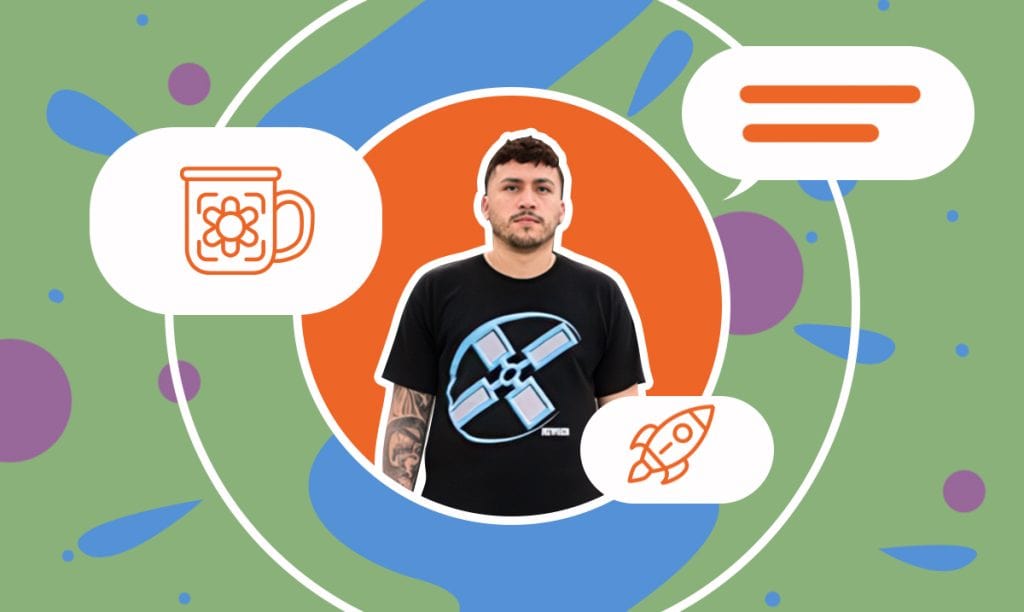Meet Vadim Bozhko, the visionary behind Bozh Studio — a branding and web design business dedicated to helping service-based companies stand out.Fu ...
Small Spaces, Sustainable Futures: The Sarah Bronstein Story
Written by: Esther Strauss
Esther is a business strategist with over 20 years of experience as an entrepreneur, executive, educator, and management advisor.
Published on January 12, 2024

Meet Sarah Bronstein, the visionary behind Sukkha Interior Design, where small spaces bloom into sustainable sanctuaries. From the bustling streets of big cities to the tranquility of a tiny travel trailer, Sarah’s journey intertwines a love for minimalist living with a passion for impactful design. In this exclusive interview, we delve into the heart of tiny house living, exploring how sustainability, functionality, and a touch of design magic transform compact corners into havens of happiness and well-being. Join us as we uncover the inspirations, challenges, and future aspirations of a designer who’s redefining the art of living large in small spaces.
Journey to Tiny House Design Specialization
SBS – What inspired you to specialize in tiny house and small space interior design?
Sarah – I spent about 15 years living in big cities like NYC and San Francisco in pretty small apartments. I’ve always been fascinated by the tiny house movement and the inherent challenges of small spaces. After designing and renovating my tiny dream home in the shell of a vintage travel trailer, I felt it was a natural time to specialize in tiny house and small space interior design.
Sustainability in Interior Design Projects
SBS – How do you approach sustainability in your design projects?
Sarah – After getting LEED certified in 2018, I try to use sustainable practices wherever possible. Although it varies from project to project, specifying VOC-free paints, incorporating eco-friendly appliances and sustainable materials, and sourcing second-hand furnishings and decor are some of the most common ways I incorporate sustainable design practices.
Overcoming Challenges in Pandemic Times
Can you describe a particularly challenging project and how you overcame those challenges?
Sarah – I had a project that was about 75% complete with the renovations and was about 2–3 weeks from installing furniture and decor when the pandemic shutdowns started. There were SO many issues and delays because no one could do anything, shipments were a disaster, and stock for replacement was sparse. I overcame those challenges by staying communicative, transparent, and empathetic to everyone involved, especially the frustrated homeowners. I ended up spending hours trying to figure out what made it and finding replacements for what didn’t while still holding up the cohesiveness of our design. When we finally finished months later the homeowners were blown away with the results and that the challenges and delays felt entirely worth it.
Interior Design Insight as a Real Estate Advantage
SBS – How has your interior design expertise, particularly in staging and envisioning property potential, given you an advantage in your recent real estate career?
Sarah – My background is actually in interior design, not real estate— I just became a realtor this past summer. I feel my experience in interior design has been invaluable as a real estate agent. In addition to a deep understanding of staging, renovation budgets, and revenue-driven design, I have an eye for the potential in properties, often seeing what others don’t. I can conceptualize the space after updates which in this competitive market gives my clients a better chance of getting exactly what they want, where they want it, within their budget.
Demystifying Tiny House Living
SBS – What are the most common misconceptions clients have about tiny house living or design?
Sarah – One common misconception I hear often is the notion that you have to be a minimalist to live in a tiny house. Minimalist is a relative term, so yes, to live in a tiny house, you’ll probably have a lot less belongings than someone in a traditional 2000 sq ft home, but that doesn’t mean you are living with less.
Balancing Aesthetics and Functionality in Small Spaces
SBS – How do you balance aesthetics with functionality in small spaces?
Sarah – Open shelving, multi-functional furniture, and built-in cabinets are some of the most common ways I balance aesthetics with functionality in tiny homes.
Current Trends in Tiny Home Interior Design
SBS – What trends are you currently seeing in the interior design industry, particularly for tiny homes?
Sarah – Lots of wood applications and sliding barn doors.
Dispelling Myths About Tiny House Living
SBS – What are the most common misconceptions clients have about tiny house living or design?
Sarah – One common misconception I hear often is the notion that you have to be a minimalist to live in a tiny house. Minimalist is a relative term so yes, to live in a tiny house you’ll probably have a lot less belongings than someone in a traditional 2000sq ft home but that doesn’t mean you are living with less. I still have an expansive wardrobe and plants and “stuff” – it’s just more limited to the things I really love and use. I like to call tiny living “intentionalist” as opposed to “minimalist”.
Staying Updated in Design and Real Estate
SBS – How do you stay updated and educated in both the design and real estate industries?
Sarah – I am in interior designer Facebook groups as well as attending local events like High Point Market.
Advice for Aspiring Design and Real Estate Entrepreneurs
SBS – What advice would you give to entrepreneurs looking to enter the interior design or real estate market?
Sarah – To make sure you love it! Both industries are extremely competitive and challenging, so make sure the actual day-to-day work is mostly enjoyable. If you don’t like what you’re doing day to day, your inevitable negative energy will repel clients and money, and it’s just not going to work.
And this next bit I’d advise to any entrepreneur or business owner in any market or industry and was told to me by my business coach, and that is to find other ways to measure your business success than just money alone. Of course, it’s important that a business brings in proper revenue, but it takes a while to build up a pipeline for steady income, and even when it’s “steady,” it’s never going to be like getting a set paycheck every two weeks. A business has peaks and valleys, and if you only look at success as financial, you’ll really struggle to get through the valleys — which is where most entrepreneurs give up.
Measuring Success in Design Projects
SBS – How do you measure the success of a design project?
Sarah – I measure the success of a design project by whether my clients’ design goals have been met. Design goals are more than just list items like “update kitchen” — the reason why that client is moving forward on updating is part of that goal.
For example, if someone hires me to design their Airbnb, I am going to be looking at things like the final listing photos, reviews, and bookings to measure the success of the project.
Ultimately, if my client is happy, the project was successful.
The Role of Technology in Design and Real Estate
SBS – What role does technology play in your design and real estate services?
Sarah – My business literally wouldn’t exist without technology.
Since most work is done and shared remotely, I would be lost without my design software, email, Zoom, the MLS, online retailers, etc…
Technology has also allowed me to work with interior design clients all over the country. Even for full-service projects, the majority of my work is remote — technology allows me the ability to video tour spaces in real-time with contractors and clients.
Future Vision for Sukkha Interior Design
SBS – How do you see Sukkha Interior Design evolving in the next few years?
Sarah – I have so many ideas on how Sukkha Interior Design can evolve and expand in the coming years! One of my biggest goals is to create a tiny house short-term rental property where guests can experience Sukkha Interior Design and connect with their surroundings.
I also have a huge interest in using tiny house designs for good. I’d love to create some sort of non-profit project that can partner with low-income housing groups or maybe partner with RV companies and maybe nationwide campgrounds/RV parks to help domestic abuse victims. I recently learned RVs can be a really good solution for domestic abuse victims who need safe housing that isn’t tied to one address or location for safety reasons. I have lots of ideas, but I’d love to have a business that makes a positive impact and that makes the benefits of tiny homes and interior design accessible.
To connect with Sarah Bronstein and dive deeper into her unique approach to tiny house and small space interior design, you can explore the following links:
- Visit her website at Sukkha Interior Design for insights into her projects and services.
- Tune into her podcast to hear more about sustainable living and interior design trends.
- Follow Sarah on Instagram and Facebook for the latest updates, tips, and behind-the-scenes glimpses into her design process.
Subscribe to Our Newsletter
and gain insider access to cutting-edge business insights and trends.
Featured Resources

How “Less but Better” Drives Bozh Studio’s Design Edge
Published on April 3, 2025
Read Now

How This Print Shop Delivers High-Quality Custom Designs
Published on March 6, 2025
In this interview, we speak with Juan Labra, CEO/creative director at New Gen Print and Design LLC, about his journey in the printing and designindu ...
Read Now

How Data and Creativity Work Together in Value-Based Design
Published on December 2, 2024
In this interview, we’re joined by Nick Disabato, the founder of Draft, a design consultancy focused on driving business growth throughvalue-b ...
Read Now
Comments